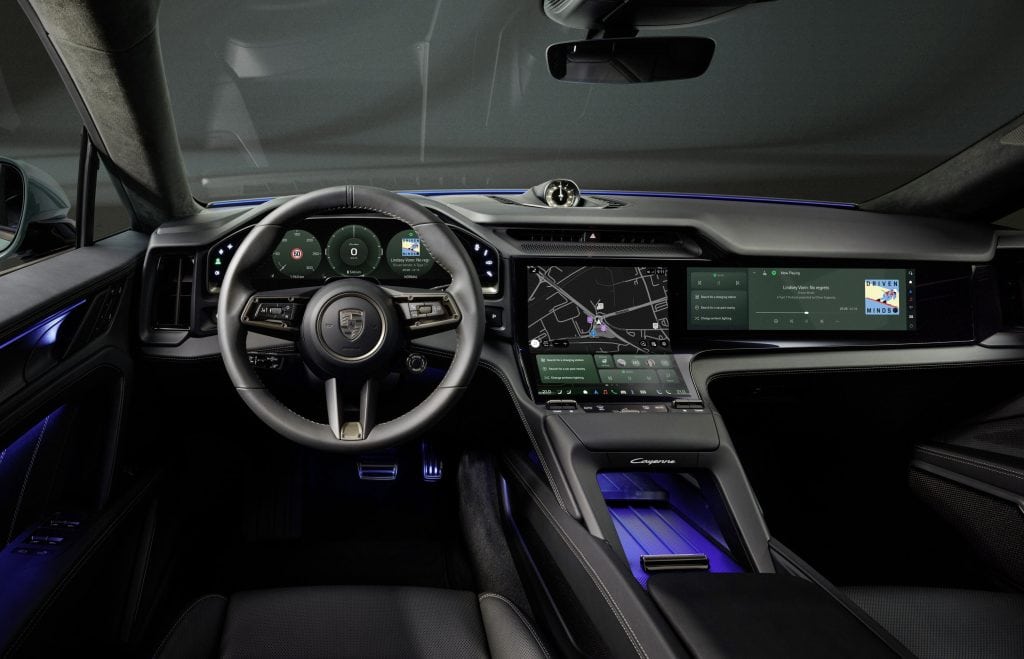
At the center of the overhaul is what Porsche calls the Flow Display, a curved OLED surface that arcs seamlessly into the center console. This digital interface, part of a broader operating concept known as Porsche Digital Interaction, is designed to balance sleek digital screens with carefully retained physical buttons for essential functions — an approach meant to preserve tactile control in an increasingly screen-driven automotive landscape.
“We wanted to merge the classic Cayenne character with forward-looking display technologies in a single, harmonious package,” Markus Auerbach, director of interior design at Style Porsche, said in a statement. “Every element has been considered down to the smallest detail.”
The Cayenne Electric’s redesign also marks a significant leap in passenger comfort. Standard electrically adjustable rear seats allow occupants to shift between lounge-like recline and cargo-friendly utility. A new set of features Porsche calls Mood Modes orchestrates lighting, sound, climate and seating functions to produce distinct atmospheres, ranging from soothing relaxation settings to energizing profiles intended to highlight the car’s performance. An expansive sliding panoramic roof — the largest ever fitted to a Porsche — can transform from transparent to matte using liquid crystal technology, offering four gradations of opacity to suit both privacy and ambience.
Another departure is surface heating, which extends beyond the seats to armrests and door panels, delivering a more efficient and evenly distributed warmth than conventional air-based systems. Extended ambient lighting, combined with intelligent communication lighting cues, further deepens the sense of refinement.
Digital convenience takes center stage with the Porsche Digital Key, allowing smartphones and smartwatches to serve as secure car keys. Built on Ultra Wideband technology, the system recognizes devices in proximity, unlocking or locking the Cayenne automatically. The digital key can be stored in mobile wallets and shared with up to seven additional users.
Customization — long a Porsche hallmark — has been taken to a new extreme. Buyers will be able to choose from 13 color combinations, four interior packages and five accent packages, yielding virtually unlimited permutations. Classic leather remains available, but new tones such as Magnesium Grey, Lavender and Sage Grey broaden the palette. For customers seeking a leather-free option, the Race-Tex interior with Pepita textile recalls patterns from Porsche’s heritage models. Additional decorative trims, contrasting stitching and accent finishes allow fine-tuned personalization.
For those who wish to go further, Porsche Exclusive Manufaktur will continue to offer bespoke detailing, while the Sonderwunsch program allows for near one-off creations. Together, these initiatives mark the most extensive range of customization options ever offered in a Cayenne.
The Flow Display, however, is likely to be the most talked-about feature. The fully digital 14.25-inch instrument cluster can be configured to prioritize navigation, performance or driver assistance systems. An optional 14.9-inch passenger display permits streaming and app use without distracting the driver, while a head-up display with augmented reality projects oversized guidance and navigation graphics directly into the driver’s view.
“The ambition behind the digital redesign was to foster a deeper, more immersive relationship between the driver and the car,” said Ivo van Hulten, Porsche’s director of driver experience. Configurable widgets, as well as a new Themes app offering five color schemes for the screens, transform the interface itself into a design element.
In-car technology also gains an AI-powered voice assistant capable of understanding natural speech and follow-up questions. The system can adjust climate, lighting or seat functions, recognize addresses and traffic data, and stream media services on command. The aim, Porsche says, is to eliminate friction between driver intent and vehicle response.
Taken together, the Cayenne Electric’s interior represents more than just a modernization of Porsche’s best-selling SUV. It is a statement about the brand’s direction: retaining the tactile, performance-oriented character that built its reputation while embracing digital fluency and customization on a scale once unthinkable in a luxury performance vehicle.